One of the more renowned units in the First Union Corps was the Iron Brigade (IB) under the command of BG Solomon Meredith. They were among the first of the Corps’ units to arrive with LTG Reynolds. He had positioned the first arrivals, Cutler’s Brigade, just to the north of Chambersburg Road. He had intended to have the IB relieve the cavalrymen holding the left flank of the Union line, but he noted movement of rebel troops (Archer’s Brigade) in Herbst’s Woods and ordered them to drive them back, since they would be threatening the newly arriving units.
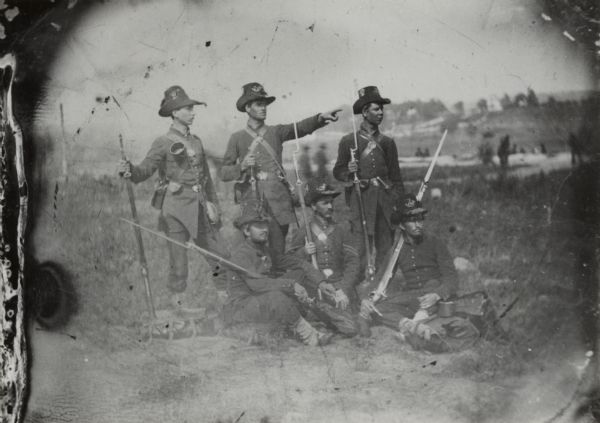
As they charged through the woods, The Iron Brigade was able to push Archer’s larger force back to Willoughby’s Run and even managed to capture BG Archer himself. But they were counter-attacked by Pettigrew and Brockenbrough and almost encircled. They made an orderly, if hasty, withdrawal back to the starting point. There they were joined with the brigades of BG Biddle and Stone. Together they held off repeated attempts to dislodge them.
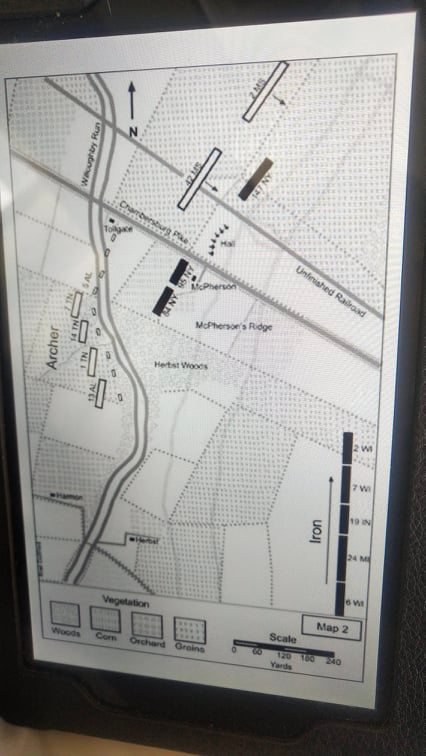
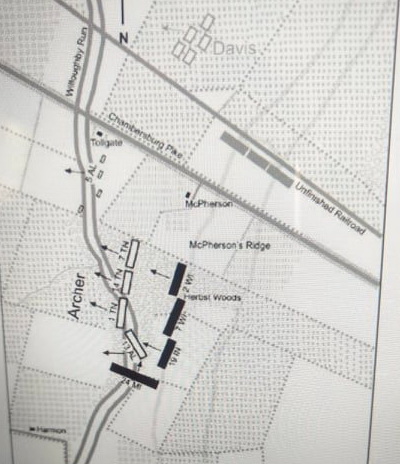
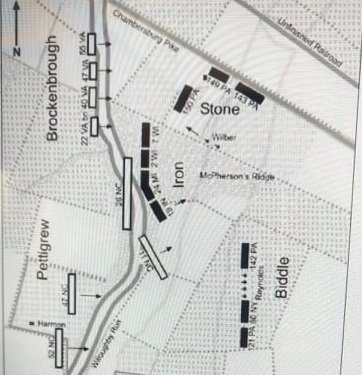
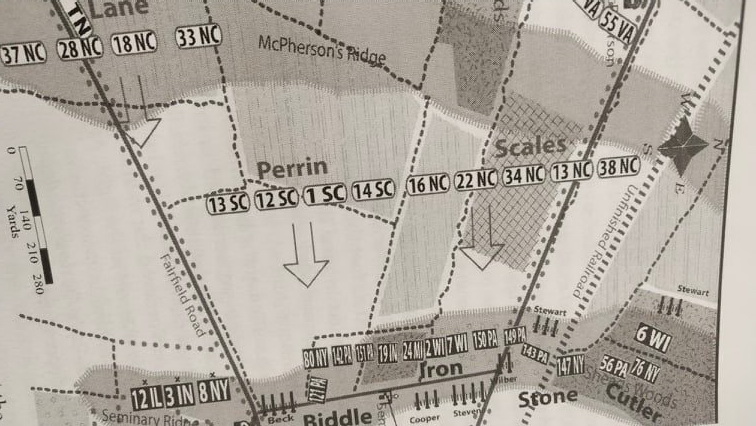
These units were amongst the last to leave the field of battle in the late afternoon of 1 July. The Iron Brigade is said to have formed up and marched away towards the rally point at the cemetery as if they were on parade. This so amazed the Rebels that neither Pettigrew nor Fry chose to pursue them.
Most historians agree that upon their arrival at the cemetery, LTG Hancock re-directed them over to Culp’s Hill. But what exactly they did their escapes most of the writers. We know that during MG Johnson’s assault against the breastworks built by elements of XIIth Corps, the IB was to the left of BG Greene’s Brigade that was left to man that barrier as other elements of the XIIth were withdrawn to support MG Sickles. We also know that a Union unit had built defensive trenches on the lower slope of Culp’s Hill that Johnson was able to occupy. But who built them? And were the builders driven out by Johnson’s attackers or had they been abandoned in favor of the breastworks higher up on the slope? Was it the Iron Brigade who started those trenches? BG Greene was a renowned civil engineer. He is said to have determined that the placement of the trenches put them in too much peril to properly defend. So he had his men build the breastworks that eventually held against Johnson.
Lance Hergeden has seemingly written the definitive work on the exploits of the Iron Brigade ay Gettysburg. In his Chapter 22, he tells of a somewhat more chaotic withdrawal from the McPherson’s Ridge battle front to the cemetery, but eventually the survivors arrived there. A few of the brigade’s regiment had to fight their way through the southern edge of the city to reach the rally point.
With the full knowledge that the entire Union line was collapsing, the senior officers in the cemetery were faced with a chaotic situation. Those in the cemetery were rapidly trying to improve their defensive. Men as individuals and small groups were trickling in from the town. There was little in the way of order or unit cohesiveness.
LTG Hancock spotted a group in black hats surrounding their unit standard. He approached and ordered the haggard survivors of the Iron Brigade – they had experienced about 60% (690 survivors of 1880 troops) casualties that day – to move over to Culp’s Hill. He knew that this dominant position would prove vital, especially if the rebels made an attempt to occupy it. Led by the 6th WI Regiment they moved east. Hergeden describes them as immediately beginning to build earthworks facing mainly to the north as they occupied the left flank of Wadsworth’s depleted division.
Apparently, it was the 78th NY of Greene’s Brigade that was providing a skirmish line on the lower slopes. Were they the ones who dug the trenches that Johnson would soon occupy on the right side of the hill? Hergeden only writes that “a portion of the abandoned Federal entrenchments on the lower part of Culp’s Hill fell to attackers”. IOW he did not identify the builders of those trenches.
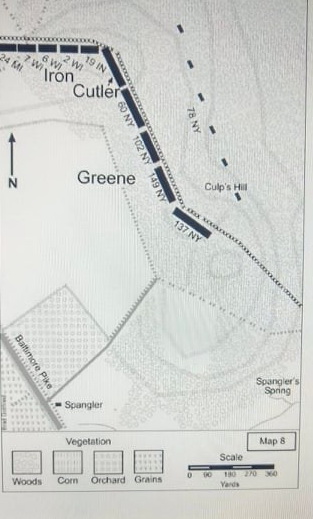
So a few questions still remain:
Were parts of the Iron Brigade among the first Union units on Culp’s Hill?
Where exactly did they establish themselves? facing which direction? Where were they when the rebel scouts reconnoitered the hill late in the day? Were they part of the larger group commanded by Wadsworth facing more or less north?
It had to be later that they moved up beside BG Greene. Twelfth Corps had arrived much later. Where was the IB before that?
If the IB did not dig the trenches that Johnson later occupied, who did?
[editor’s note: even the American Battlefield Trust denies knowledge of who built those trenches] https://www.facebook.com/americanbattlefieldtrust/
================
In summary then, I freely admit that my understanding of the precise movements of the Iron Brigade was faulty; due mainly to the limited information provided by historians who were providing an overview. For example, my go-to book for the overall battle story is KUNKEL’s Our Fathers at Gettysburg. But in his account the IB disappears for 200 pages between pages 90 and 300. His account of their exploits fails to explain how they ended up in Herbst’s Woods and where they went after their withdrawal on Day 1. Likewise, Sears and Coddington do little to clarify their movements after the battle on Day 1. It took a read of Hergeden to clarify the errors and assumptions I had made. They were ordered into those woods; have success in routing Archer, but were surprised by an attack by Pettigrew. My biggest error was that the IB had been responsible for the trenches on Culp’s Hill. It is still not clear who did build them, only that they were indeed build and then occupied by rebel forces on Day 2.
There is also room for confusion in that part of First Corps (Biddle’s Bde) was attached to Second Corps and stood in the path of Pickett on Day 3. During that time the IB was still on the north end of Culp’s Hill.
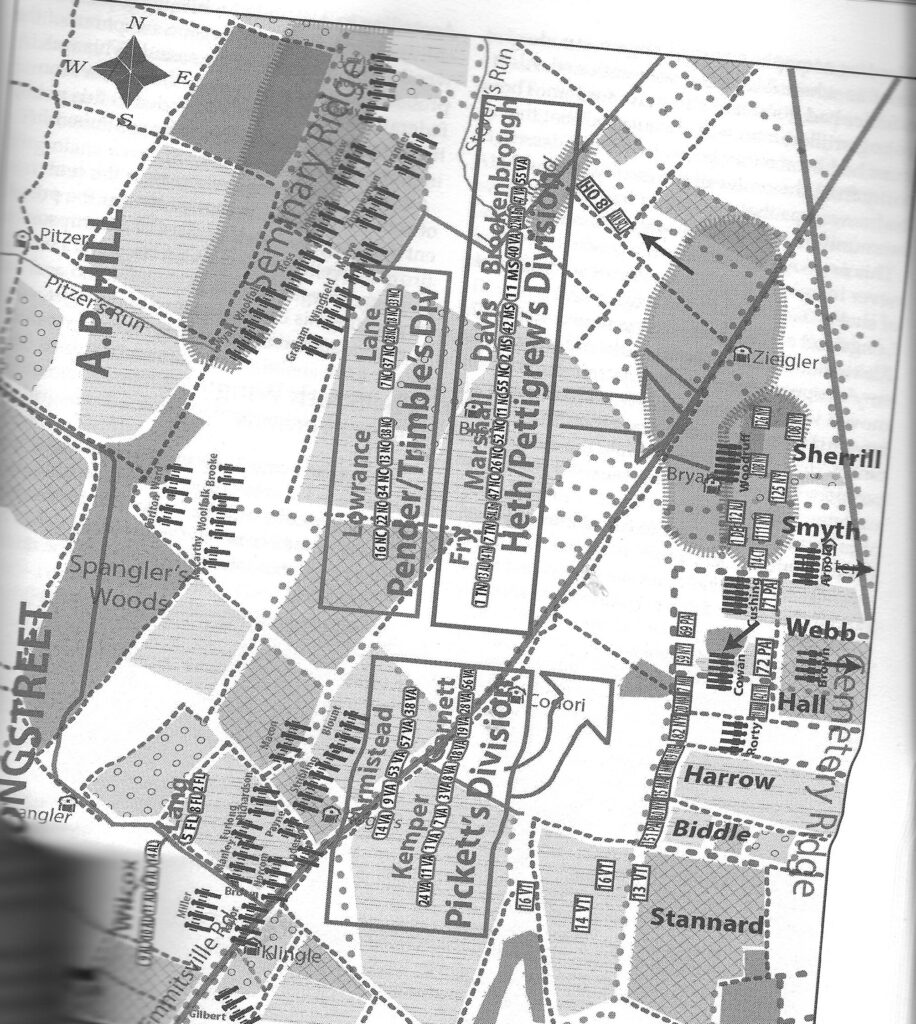
Their full story can be found here:
https://en.wikipedia.org/wiki/Iron_Brigade
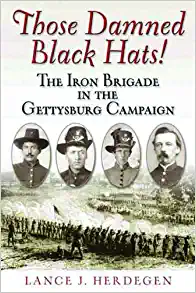
- A few of the maps / diagrams of Union positions above were extracted from Hergeden’s book as the best available to illustrate their location.
6th Wisconsin Regiment side-story:
Twice during this epic clash the 6th Wisconsin Regiment was a called upon to reinforce positions outside of those being defended by the Iron Brigade. As the brigade deployed near the Lutheran Seminary area on Day 1, the 6th was held in reserve. But one of MG Heth’s brigades just north of the Chambersburg Road wheeled right and moved to attack the thinly held Union line along the south of that road. The 6th was ordered to reinforce that line. When most of the Confederate line disappeared, the 6th charged forward and found them trapped in the unfinished railroad cut. Many of the rebels were captured in that action.
On Day 2, MG Johnson’s division of Ewell’s Corps assaulted Culp’s Hill from the east. While most of the survivors of the Iron Brigade manned breastworks facing to the north and were not directly involved in that defense, the 6th was once again detached and moved to support BG Greene’s Brigade in defending against that attack. They were hailed for they swift and decisive actions at a point known as the Traverse in that defensive line.
